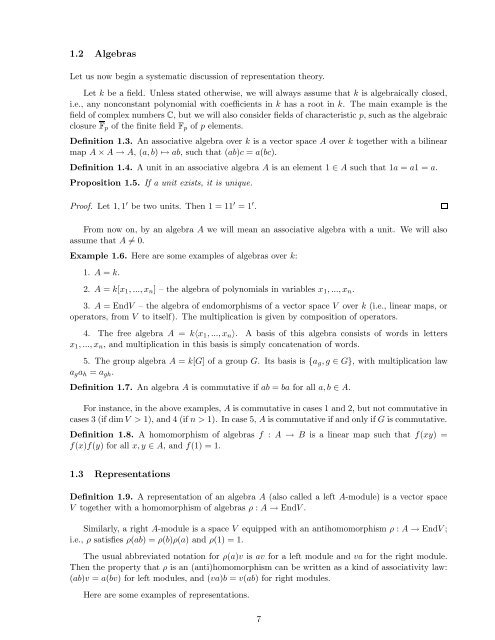Lecture notes for Introduction to Representation Theory
Lecture notes for Introduction to Representation Theory
Lecture notes for Introduction to Representation Theory
You also want an ePaper? Increase the reach of your titles
YUMPU automatically turns print PDFs into web optimized ePapers that Google loves.
1.2 Algebras<br />
Let us now begin a systematic discussion of representation theory.<br />
Let k be a field. Unless stated otherwise, we will always assume that k is algebraically closed,<br />
i.e., any nonconstant polynomial with coefficients in k has a root in k. The main example is the<br />
field of complex numbers C, but we will also consider fields of characteristic p, such as the algebraic<br />
closure F p of the finite field F p of p elements.<br />
Definition 1.3. An associative algebra over k is a vec<strong>to</strong>r space A over k <strong>to</strong>gether with a bilinear<br />
map A × A ⊃ A, (a, b) ⊃ ab, such that (ab)c = a(bc).<br />
Definition 1.4. A unit in an associative algebra A is an element 1 A such that 1a = a1 = a.<br />
Proposition 1.5. If a unit exists, it is unique.<br />
Proof. Let 1, 1 be two units. Then 1 = 11 = 1 .<br />
From now on, by an algebra A we will mean an associative algebra with a unit. We will also<br />
assume that A ⇒= 0.<br />
Example 1.6. Here are some examples of algebras over k:<br />
1. A = k.<br />
2. A = k[x 1 , ..., x n ] – the algebra of polynomials in variables x 1 , ..., x n .<br />
3. A = EndV – the algebra of endomorphisms of a vec<strong>to</strong>r space V over k (i.e., linear maps, or<br />
opera<strong>to</strong>rs, from V <strong>to</strong> itself). The multiplication is given by composition of opera<strong>to</strong>rs.<br />
4. The free algebra A = k◦x 1 , ..., x n . A basis of this algebra consists of words in letters<br />
x 1 , ..., x n , and multiplication in this basis is simply concatenation of words.<br />
5. The group algebra A = k[G] of a group G. Its basis is {a g , g G}, with multiplication law<br />
a g a h = a gh .<br />
Definition 1.7. An algebra A is commutative if ab = ba <strong>for</strong> all a, b A.<br />
For instance, in the above examples, A is commutative in cases 1 and 2, but not commutative in<br />
cases 3 (if dim V > 1), and 4 (if n > 1). In case 5, A is commutative if and only if G is commutative.<br />
Definition 1.8. A homomorphism of algebras f : A ⊃ B is a linear map such that f(xy) =<br />
f(x)f(y) <strong>for</strong> all x, y A, and f(1) = 1.<br />
1.3 <strong>Representation</strong>s<br />
Definition 1.9. A representation of an algebra A (also called a left A-module) is a vec<strong>to</strong>r space<br />
V <strong>to</strong>gether with a homomorphism of algebras δ : A ⊃ EndV .<br />
Similarly, a right A-module is a space V equipped with an antihomomorphism δ : A ⊃ EndV ;<br />
i.e., δ satisfies δ(ab) = δ(b)δ(a) and δ(1) = 1.<br />
The usual abbreviated notation <strong>for</strong> δ(a)v is av <strong>for</strong> a left module and va <strong>for</strong> the right module.<br />
Then the property that δ is an (anti)homomorphism can be written as a kind of associativity law:<br />
(ab)v = a(bv) <strong>for</strong> left modules, and (va)b = v(ab) <strong>for</strong> right modules.<br />
Here are some examples of representations.<br />
7

















